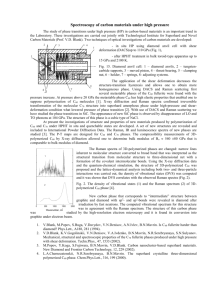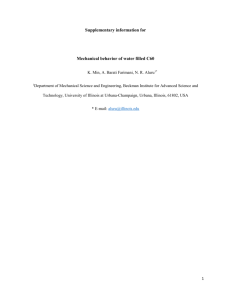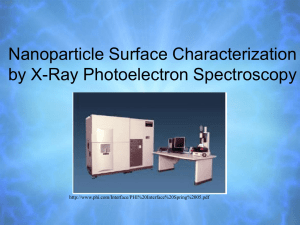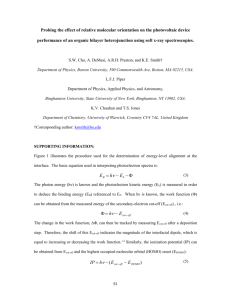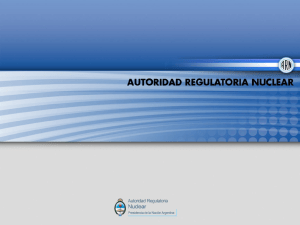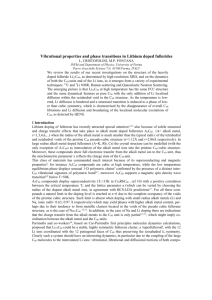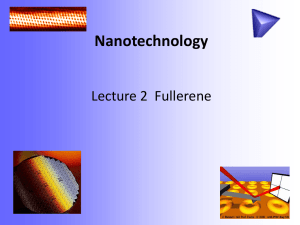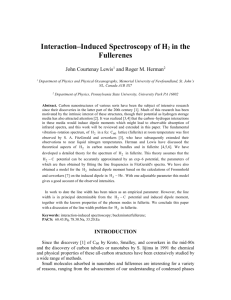supplementary_information-10-19-2009
advertisement
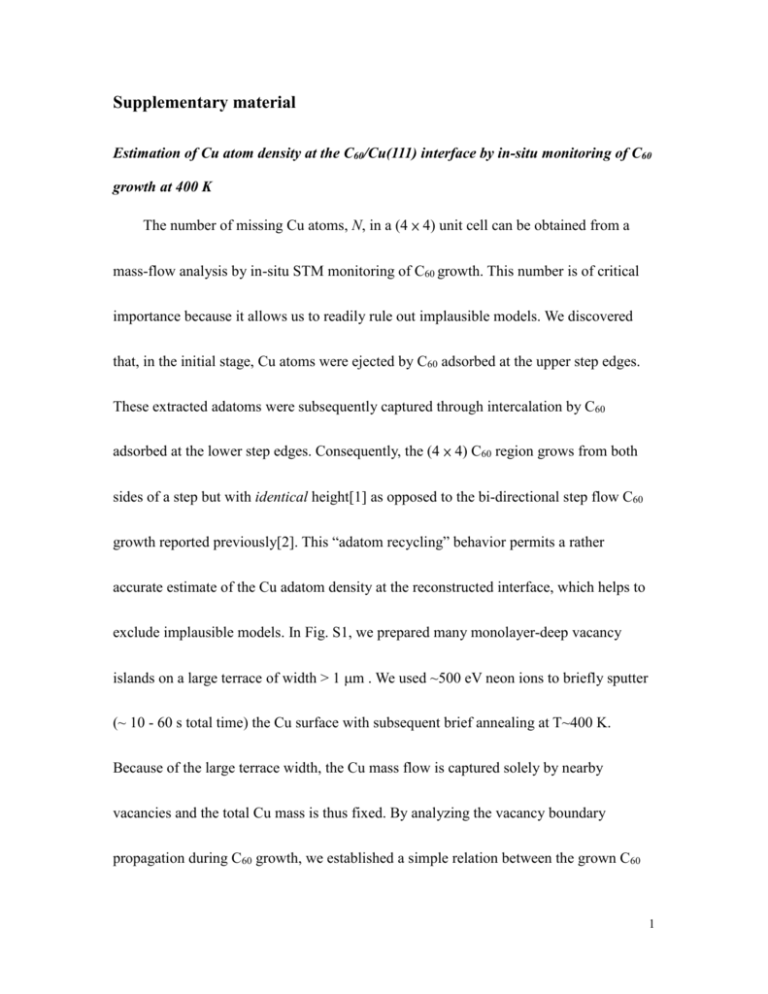
Supplementary material Estimation of Cu atom density at the C60/Cu(111) interface by in-situ monitoring of C60 growth at 400 K The number of missing Cu atoms, N, in a (4 × 4) unit cell can be obtained from a mass-flow analysis by in-situ STM monitoring of C60 growth. This number is of critical importance because it allows us to readily rule out implausible models. We discovered that, in the initial stage, Cu atoms were ejected by C60 adsorbed at the upper step edges. These extracted adatoms were subsequently captured through intercalation by C60 adsorbed at the lower step edges. Consequently, the (4 × 4) C60 region grows from both sides of a step but with identical height[1] as opposed to the bi-directional step flow C60 growth reported previously[2]. This “adatom recycling” behavior permits a rather accurate estimate of the Cu adatom density at the reconstructed interface, which helps to exclude implausible models. In Fig. S1, we prepared many monolayer-deep vacancy islands on a large terrace of width > 1 m . We used ~500 eV neon ions to briefly sputter (~ 10 - 60 s total time) the Cu surface with subsequent brief annealing at T~400 K. Because of the large terrace width, the Cu mass flow is captured solely by nearby vacancies and the total Cu mass is thus fixed. By analyzing the vacancy boundary propagation during C60 growth, we established a simple relation between the grown C60 1 areas interior (Si) and exterior (Se) to the original vacancy boundary (Vb). That is, S e N Si (16 N ) , where N is the number of Cu atoms removed in each unreconstructed (4 × 4) unit cell. From a series of ~ 20 images, we calculated N from image pairs and obtained N=7.1±0.7. Figure S1 At 400 K the interface already fully reconstructs. Identical C60 areas grow from both sides of the vacancy boundary (Vb), through transporting ejected Cu adatoms from the C60 region exterior to the vacancies (Se) to the C60 region interior to the vacancies (Si). a, C60 coverage at 0.05 ML. b, C60 coverage at 0.30 ML. Image size: 500 nm × 500 nm. From a series of ~ 20 images like those presented here, we calculated N using the formula S e N Si (16 N ) , from image pairs. In the upper right inset, the horizontal axis (DATA) indexes the time difference (number of image frames) of the calculated image pairs. We obtained N=7.1±0.7. Structure of a stacked monolayer C60 island 2 Figure S2 A monolayer C60 island can show stacked layers because of coexisting reconstructed and unreconstructed interfaces. There are three distinct regions A, B, C. A line profile passing region C-A-B is shown. Image size: 50 nm × 50 nm. Image taken at 77 K. The C60 island was prepared at room temperature. Figure S2 illustrates a stacked monolayer C60 island and the STM topographic height line profile of three regions; (A) C60 region with reconstructed interface, (B) C60 region 3 with unreconstructed interface, and (C) C60 region with reconstructed interface plus one additional Cu layer underneath. The topographic height in area B is ~ 0.4 Å slightly lower than that in area C, because a C60 in a 7-atom vacancy hole cannot "sink" by a full monolayer step height. The STS spectra at regions A and C are identical, but are different from the spectra at region B. Ab-initio calculation details We performed ab initio band structure calculations using the highly accurate full-potential projected augmented wave method, as implemented in the VASP package, within the local density approximation with generalized gradient correction (GGA). The unreconstructed and reconstructed systems are modeled by a (4 × 4) C60 monolayer at hcp or fcc sites on a Cu(111) slab (thickness ranging from 8 to 30 Cu layers). The periodic slabs are separated by 10 Å vacuum slabs. The very thick Cu slab (e.g., 30 layers) is needed to extract the C60 band dispersion and obtain convergence of the r-fcc and r-hcp model energy difference. The calculations were performed on a 41 k-point mesh over the irreducible Brillouin zone, using 450,000 plane waves with a cut-off energy of 400 eV and with full lattice relaxation. The LUMO-derived and HOMO bands were extracted by analyzing the carbon-projected electron density. The calculated bands, depicted as the 4 white circles and white dashed guide line in Fig. 1b, are aligned to EF and scaled in such a way to match the measured and calculated HOMO band energy. Comparison of best-fit LEED model and the best-energy model Our best-fit LEED is calculated with Barbieri/Van Hove SATLEED package(see http://www.ap.cityu.edu.hk/personal-website/Van-Hove_files/leed/leedpack.html).The calculated coordinates perpendicular to the surface differ from the best-energy model by ~0.05 Å to 0.1 Å for C60 and ~0.13 Å to 0.2 Å for Cu, consistent with the decreasing LEED sensitivity with depth caused by electron damping; parallel to the surface, we found differences of ~0.05 Å to 0.2 Å, mainly because LEED is less sensitive to parallel coordinates. We note that the best-energy model is obtained for temperature T=0 K and the best-fit LEED model is for T=300 K. Energy difference between models of reconstructed and unreconstructed C60/Cu(111) interfaces The total energy in the reconstructed and unreconstructed cases should be compared with care since they are of different system sizes. The adsorption energies are ~3.0 eV/cell and ~0.8 eV/cell, respectively. The energy cost for substrate reconstruction, 5 estimated as the surface energy difference (~2.0 eV/cell) in both cases, is subtracted from the ~3.0 eV/cell value. Therefore, the reconstructed model is favored by ~0.2 eV/cell over the unreconstructed case. [1] C. H. Lin et al., Journal of Nanoscience and Nanotechnology 8, 602 (2008). [2] J. C. Dunphy et al., Surface Science 383, L765 (1997). 6

